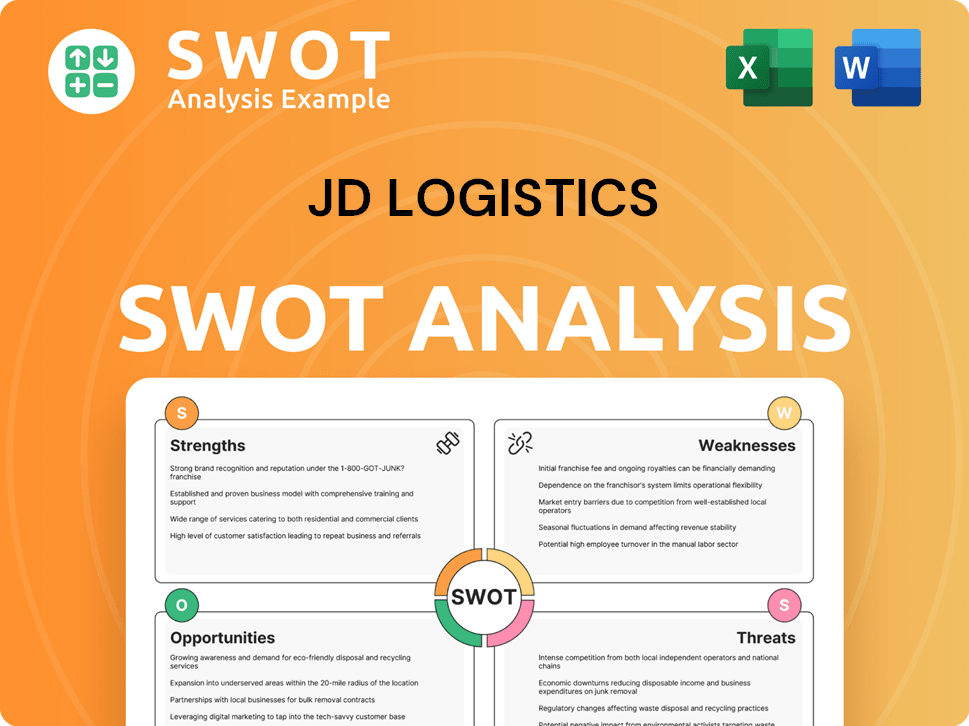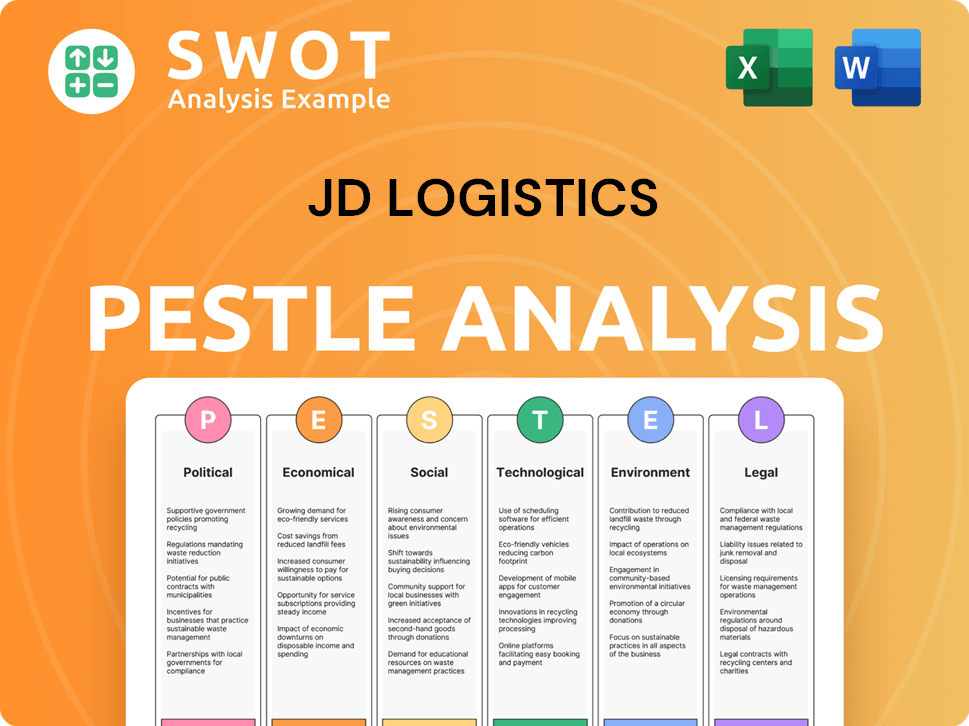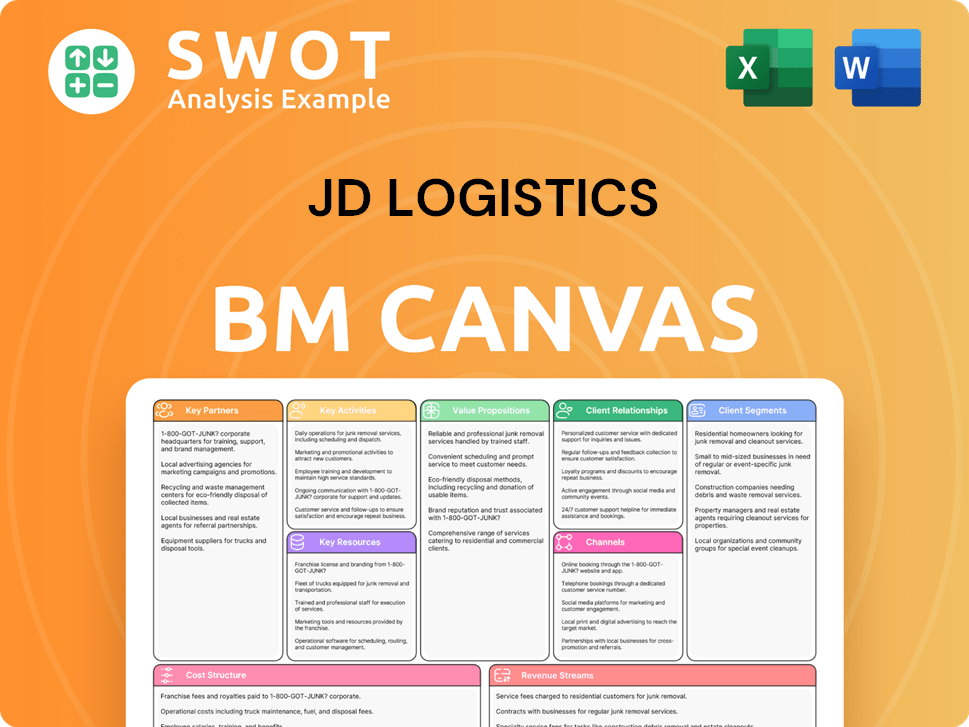JD Logistics Bundle
Can JD Logistics Conquer the Logistics World?
The logistics industry is undergoing a massive transformation, fueled by tech and shifting consumer demands. JD Logistics, a major player in China, has rapidly evolved from an internal e-commerce arm to a publicly traded powerhouse. Its impressive growth and innovative approach make it a compelling case study in a dynamic market.

To understand JD Logistics' potential, a deep dive into its JD Logistics SWOT Analysis and its competitive landscape is essential. This analysis will explore the company's key strengths, weaknesses, and its position relative to its JD Logistics competitors. We'll also delve into JD Logistics market analysis, examining its financial performance and future outlook within the booming Logistics industry China.
Where Does JD Logistics’ Stand in the Current Market?
JD Logistics holds a significant market position, especially within the logistics industry in China. Its focus on premium logistics services distinguishes it in a competitive sector. The company's brand strength is globally recognized, ranking second among the world's strongest logistics brands.
The company offers a range of services, including warehousing and distribution, integrated supply chain solutions, express delivery, and freight delivery. JD Logistics provides comprehensive supply chain solutions, helping businesses reduce costs and boost efficiency. This strategic approach is key to understanding the JD Logistics competitive landscape.
Its extensive geographic presence includes over 1,600 warehouses in China and nearly 100 worldwide, totaling 32 million square meters of logistics space. As of December 31, 2024, its overseas warehouses covered 19 countries and regions. JD Logistics serves diverse customer segments, including FMCG, fresh produce, apparel, and electronics. The company's success is also discussed in detail in the Marketing Strategy of JD Logistics.
JD Logistics operates across warehousing, distribution, express delivery, and freight services. It provides integrated supply chain solutions, streamlining operations for businesses. The company's extensive network and service offerings are key to its market position.
JD Logistics offers premium logistics services, focusing on efficiency and cost reduction for clients. Its value lies in comprehensive supply chain solutions, from manufacturing to end-customers. This approach helps enterprises optimize their operations.
JD Logistics primarily targets the e-commerce sector and businesses needing supply chain solutions. Its services are tailored to meet the needs of various industries. The company's focus on premium services sets it apart in the logistics industry China.
JD Logistics has a strong presence in China, with over 1,600 warehouses. It is expanding its international footprint, with warehouses in 19 countries and regions. This expansion is crucial for its growth strategy.
In the first quarter of 2025, JD Logistics reported a revenue increase of 11.5% year-over-year, reaching RMB 46.97 billion (US$6.5 billion). Its non-IFRS profit for 2024 reached RMB 7.9 billion, a 186.8% year-over-year increase.
- JD Logistics market share 2024 is significant, especially in China.
- The company's focus on supply chain solutions is a key differentiator.
- External customers contributed approximately 70% of its total revenue in 2024, amounting to 127.8 billion yuan.
- JD Logistics plans to target double-digit growth in 2025, reflecting its positive outlook.
JD Logistics SWOT Analysis
- Complete SWOT Breakdown
- Fully Customizable
- Editable in Excel & Word
- Professional Formatting
- Investor-Ready Format

Who Are the Main Competitors Challenging JD Logistics?
The Owners & Shareholders of JD Logistics operates within a fiercely competitive environment, facing both direct and indirect challenges. The logistics industry in China is particularly dynamic, with numerous players vying for market share. Understanding the JD Logistics competitive landscape is crucial for assessing its position and future prospects.
Key competitors include both global and domestic companies. The market is characterized by rapid technological advancements and evolving consumer demands, requiring constant adaptation and innovation. This analysis will delve into the major players impacting the company's performance and strategic direction.
The express delivery sector in China is dominated by a few major providers, creating intense competition. This competitive pressure necessitates strategic responses to maintain and grow market share.
Global logistics companies such as DHL, FedEx, UPS, and Nippon Express pose significant competition. These companies have extensive international networks and established reputations. They compete with the company in cross-border logistics and supply chain solutions.
The top eight express delivery providers in China control approximately 94% of the market. This concentration indicates intense competition among domestic players. This market share data highlights the challenges and opportunities within the logistics industry China.
SF Express is a major direct competitor, offering a wide range of services. Alibaba's Cainiao Network is another significant player, leveraging its e-commerce ecosystem. These companies provide similar services, competing directly with the company's supply chain solutions.
ZTO Express, YTO Express, STO Express, and Yunda Express are key players in the express parcel delivery market. These companies compete for market share in the domestic delivery segment. Their presence adds to the competitive dynamics.
Companies like RightHand Robotics, Third Wave Automation, and Kindred compete in technology-driven warehouse automation. These companies offer solutions that enhance efficiency and reduce costs. This competition drives innovation in the sector.
The company's entry into the food delivery sector with JD Takeaway in February 2025 positions it against Meituan. This move leverages its logistics network to compete in a new segment. Mergers and acquisitions, such as the acquisition of Deppon Logistics, also impact the competitive landscape.
Several factors determine success in the JD Logistics competitive landscape. These factors include service quality, pricing, technology adoption, and network coverage. The ability to offer efficient and reliable services is crucial for customer satisfaction.
- Market Share: The company's market share in the express delivery and supply chain solutions segments.
- Service Offerings: The range of services, including express delivery, warehousing, and supply chain financing.
- Technology: The use of automation, AI, and data analytics to improve efficiency and customer experience.
- Network: The extent and reach of the logistics network, including domestic and international coverage.
- Customer Satisfaction: Ratings and reviews reflecting the quality of service and customer experience.
JD Logistics PESTLE Analysis
- Covers All 6 PESTLE Categories
- No Research Needed – Save Hours of Work
- Built by Experts, Trusted by Consultants
- Instant Download, Ready to Use
- 100% Editable, Fully Customizable

What Gives JD Logistics a Competitive Edge Over Its Rivals?
In the dynamic JD Logistics competitive landscape, the company distinguishes itself through a combination of strategic initiatives and operational excellence. Key milestones include the continuous expansion of its warehousing network and the integration of advanced technologies to optimize supply chain efficiency. These moves have solidified its position in the logistics industry in China and beyond.
JD Logistics focuses on providing comprehensive supply chain solutions, leveraging its proprietary technologies and extensive infrastructure. This approach enables the company to offer fast and reliable delivery services, which are crucial in the competitive e-commerce logistics market. Its commitment to innovation and customer satisfaction further enhances its competitive edge.
JD Logistics has built a robust competitive advantage through strategic investments in infrastructure, technology, and brand recognition. This has allowed it to offer superior services compared to many of its JD Logistics competitors.
JD Logistics offers integrated supply chain solutions that enhance efficiency and reduce costs for businesses. This comprehensive approach covers the entire process, from manufacturing to end-customers. The 'JD Logistics Super Brain' uses AI and big data to optimize various logistics processes.
The company operates a vast network of warehouses and delivery personnel. As of May 2025, JD Logistics manages over 1,600 warehouses in China and nearly 100 overseas warehouses across 19 countries. This extensive network, combined with approximately 350,000 in-house delivery personnel, allows for industry-leading inventory turnover rates.
JD Logistics benefits from strong brand recognition, ranking second among the world's strongest logistics brands. This brand equity, combined with a focus on premium services, helps create higher margins. Its integration with JD.com's e-commerce platform provides a stable demand base.
Continuous investments in technology, including AI-powered robotics and reusable cold chain delivery boxes, enhance operational efficiency. These innovations improve service quality and sustainability efforts. These advancements contribute to its competitive advantage.
JD Logistics' competitive advantages are sustainable due to the significant capital investment and technological expertise required to replicate them. The company's ability to continuously innovate and adapt to industry shifts is crucial for maintaining its leading position, as highlighted in the analysis of Revenue Streams & Business Model of JD Logistics.
JD Logistics' key strengths include its integrated supply chain solutions, extensive infrastructure, strong brand equity, and technological innovation. These factors contribute to its ability to offer fast, reliable, and cost-effective logistics services. The company's focus on customer satisfaction and continuous improvement further strengthens its market position.
- Proprietary Integrated Supply Chain (ISC) Solutions
- Extensive Warehouse Network
- Strong Brand Recognition
- Technological Innovation
JD Logistics Business Model Canvas
- Complete 9-Block Business Model Canvas
- Effortlessly Communicate Your Business Strategy
- Investor-Ready BMC Format
- 100% Editable and Customizable
- Clear and Structured Layout

What Industry Trends Are Reshaping JD Logistics’s Competitive Landscape?
The logistics industry is undergoing significant transformation, driven by technological advancements, shifting consumer expectations, and a growing emphasis on sustainability. These trends shape the JD Logistics competitive landscape, presenting both challenges and opportunities. As the logistics industry in China continues to expand, understanding these dynamics is crucial for assessing JD Logistics' market analysis and future prospects.
JD Logistics' competitors face intense price competition and potential regulatory scrutiny. Furthermore, economic fluctuations and demand shifts could impact revenue. However, the global logistics market's projected growth and strategic expansions offer substantial opportunities. JD Logistics is actively pursuing premium services and international markets, aiming for significant growth in the coming years.
Technological advancements, including AI, big data, and IoT, are automating services and improving decision-making. Consumer demand for faster delivery and sustainable practices, such as the use of electric vehicles and renewable energy, are also key trends. The logistics industry in China saw a peak of 174.5 billion parcels in 2024.
Intense price competition in China's express delivery sector presents a significant challenge. Regulatory scrutiny and potential demand slowdowns, especially in areas like appliance sales, could impact revenue. Aggressive investments in infrastructure and technology lead to short-term cost increases, which can put pressure on margins.
The global logistics market is projected to grow at a CAGR of 9.6% from 2025 to 2032. JD Logistics is expanding in premium services and international markets, targeting double-digit growth in 2025. Government trade-in subsidies and growing demand for specialized services, such as home appliance delivery, offer further growth opportunities.
JD Logistics plans to double its overseas warehouse space by the end of 2025 and establish a '2-3 Day Delivery Circle' in dozens of overseas markets. They are also expanding international express delivery services to approximately 80 countries and regions by the end of 2024. Strategic partnerships and a commitment to sustainability further enhance market reach and value.
JD Logistics leverages its existing infrastructure to diversify into new sectors, such as food delivery, and forms strategic partnerships. These partnerships include collaborations with China Railway Express for high-speed rail express parcel delivery and with global consumer goods brands for integrated supply chain operations. The company's focus on sustainable practices, including the use of new reusable cold chain delivery boxes and aiming for 100% new energy logistics transportation by 2030, aligns with global environmental concerns.
- Expanding international express delivery services to approximately 80 countries and regions by the end of 2024.
- Doubling overseas warehouse space by the end of 2025 to support international expansion.
- Establishing a '2-3 Day Delivery Circle' in dozens of overseas markets.
- Leveraging partnerships and technological innovations to enhance supply chain solutions.
For more insights into JD Logistics' growth strategies, consider reading the Growth Strategy of JD Logistics article.
JD Logistics Porter's Five Forces Analysis
- Covers All 5 Competitive Forces in Detail
- Structured for Consultants, Students, and Founders
- 100% Editable in Microsoft Word & Excel
- Instant Digital Download – Use Immediately
- Compatible with Mac & PC – Fully Unlocked

Related Blogs
- What are Mission Vision & Core Values of JD Logistics Company?
- What is Growth Strategy and Future Prospects of JD Logistics Company?
- How Does JD Logistics Company Work?
- What is Sales and Marketing Strategy of JD Logistics Company?
- What is Brief History of JD Logistics Company?
- Who Owns JD Logistics Company?
- What is Customer Demographics and Target Market of JD Logistics Company?
Disclaimer
All information, articles, and product details provided on this website are for general informational and educational purposes only. We do not claim any ownership over, nor do we intend to infringe upon, any trademarks, copyrights, logos, brand names, or other intellectual property mentioned or depicted on this site. Such intellectual property remains the property of its respective owners, and any references here are made solely for identification or informational purposes, without implying any affiliation, endorsement, or partnership.
We make no representations or warranties, express or implied, regarding the accuracy, completeness, or suitability of any content or products presented. Nothing on this website should be construed as legal, tax, investment, financial, medical, or other professional advice. In addition, no part of this site—including articles or product references—constitutes a solicitation, recommendation, endorsement, advertisement, or offer to buy or sell any securities, franchises, or other financial instruments, particularly in jurisdictions where such activity would be unlawful.
All content is of a general nature and may not address the specific circumstances of any individual or entity. It is not a substitute for professional advice or services. Any actions you take based on the information provided here are strictly at your own risk. You accept full responsibility for any decisions or outcomes arising from your use of this website and agree to release us from any liability in connection with your use of, or reliance upon, the content or products found herein.